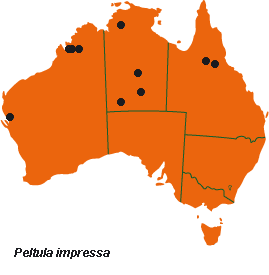



Australian Biological Resources Study
| Checklist of the Lichens of Australia and its Island Territories | ||
| Introduction | A–D | E–O | P–R | S–Z | Oceanic Islands | References | ||
| Peltula impressa (Vain.) Swinscow & Krog | ||
| Norweg. J. Bot. 26: 219 (1979); Heppia impressa Vain., Beibl. Hedwigia 37: 43 (1898). T: "Africa centr. Ruwenzori exped.: in rupe gneissacea 1300 ped. S. m. in viciniis montis Ruwenzori", Scott Elliot 14; holo: TUR-VAINIO 12492. | ||
| Thallus compound; central squamules obconical to clavate or cylindrical, convex or flattened apically, 0.4–0.8 mm long, 0.2–0.5 mm wide, olive-brown, smooth; marginal squamules effigurate, orbicular or sometimes almost ribbon-like. Upper cortex absent; epinecral layer 6–12 µm thick, yellowish. Medulla comprising densely interwoven hyphae with globose to elongated cells, 2.5–3 µm thick, with a poorly defined photobiont layer in the upper part. Lower cortex paraplectenchymatous, 15–24 µm thick, with globose hyphal cells 5–8 µm diam. Apothecia immersed in central squamules, 1 or 2 (or 3) per squamule; disc 0.1–0.3 mm diam., red-brown to black. Asci clavate to obclavate; ascus wall red-brown in iodine, blue after pretreatment with KOH. Ascospores more than 64 per ascus, globose to ellipsoidal, 3.5–5 (–7) × 2.4–3.5 (–4) µm. Pycnidia globose, very rare; conidia not known. |  |
|
| Occurs in northern W.A., N.T. and Qld; grows mainly on acidic rocks in grassland, desert and in other open arid habitats. Also in Brazil, Mexico, south-western U.S.A., Africa and Hong Kong. | ||
| Büdel (2001) | ||
| Checklist Index |
| Introduction | A–D | E–O | P–R | S–Z | Oceanic Islands | References |
This work is copyright. Apart from any use as permitted under the Copyright Act 1968, no part may be reproduced by any process without prior written permission from Australian Biological Resources Study. Requests and inquiries concerning reproduction and rights should be addressed in the first instance to Dr P. McCarthy. These pages may not be displayed on, or downloaded to, any other server without the express permission of ABRS.